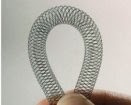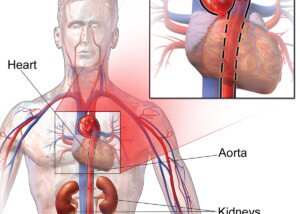
Stent graft repair of thoracic aortic aneurysms is becoming more and more commonplace, replacing the riskier open heart surgery.
Open chest surgery for treating a thoracic aortic aneurysm is highly invasive, can take up to eight hours, and months to recover from.
There can also be serious complications such as kidney injury.
So is there any way to treat aortic aneurysm without cutting open the chest?
Yes, there is. It is called the stent graft.
A stent graft can repair this serious condition, and patients usually go home after one or two days, versus the one to two weeks required for the open chest surgery.
- The stent graft is a polyester tube that is covered with metal webbing.
- The surgeon uses a catheter, or thin tube, to deliver the stent graft, via the patient’s groin in an artery.
- The catheter is guided into the chest artery: the thoracic aorta.
- At the predetermined location, the stent graft is deployed, and it expands to the arterial walls.
- The stent graft can range from 1-2 inches wide, to 4-8 inches long.
“Stent grafts have grown in popularity and have become quite sophisticated,” says Michael Fiocco, MD, Chief of Open Heart Surgery at Union Memorial Hospital in Baltimore, Maryland, one of the nation’s top 50 heart hospitals.
“Most thoracic aortic aneurysms can be treated with a TEVAR (thoracic endovascular aortic repair),” continues Dr. Fiocco.
“The vast majority of TAA beyond the aortic arch are treated this way (beyond the left subclavian artery).
“The aortic arch, where the arteries to the arms and brain arise from the aorta, is much more of a challenge for TEVAR, and is a quite complex open surgery for aneurysm as well.
“Treatment of the TAA in the ascending aorta with TEVAR is still in its early development due to the need to avoid the coronary arteries at one end and the aortic arch with its branches at the other.”
Silent Killer
It is estimated that about 60,000 Americans have a thoracic aortic aneurysm: an abnormally dilated aortic vessel.
There are usually no symptoms, and they are normally discovered incidentally via imaging tests for other concerns such as suspected pneumonia.
Treatment at that point depends on the size of the aortic aneurysm.
Depending on the size, the treatment will include that of regular imaging tests to track the growth rate of the artery’s bulging portion.
If it reaches a certain size, usually 5.5 cm, or if the growth exceeds a certain rate per year, or if there are symptoms like chest pain and shortness of breath, surgery will be discussed.
Otherwise, the watchful-eye approach is used, along with lifestyle modifications including no smoking, and blood pressure control.










































